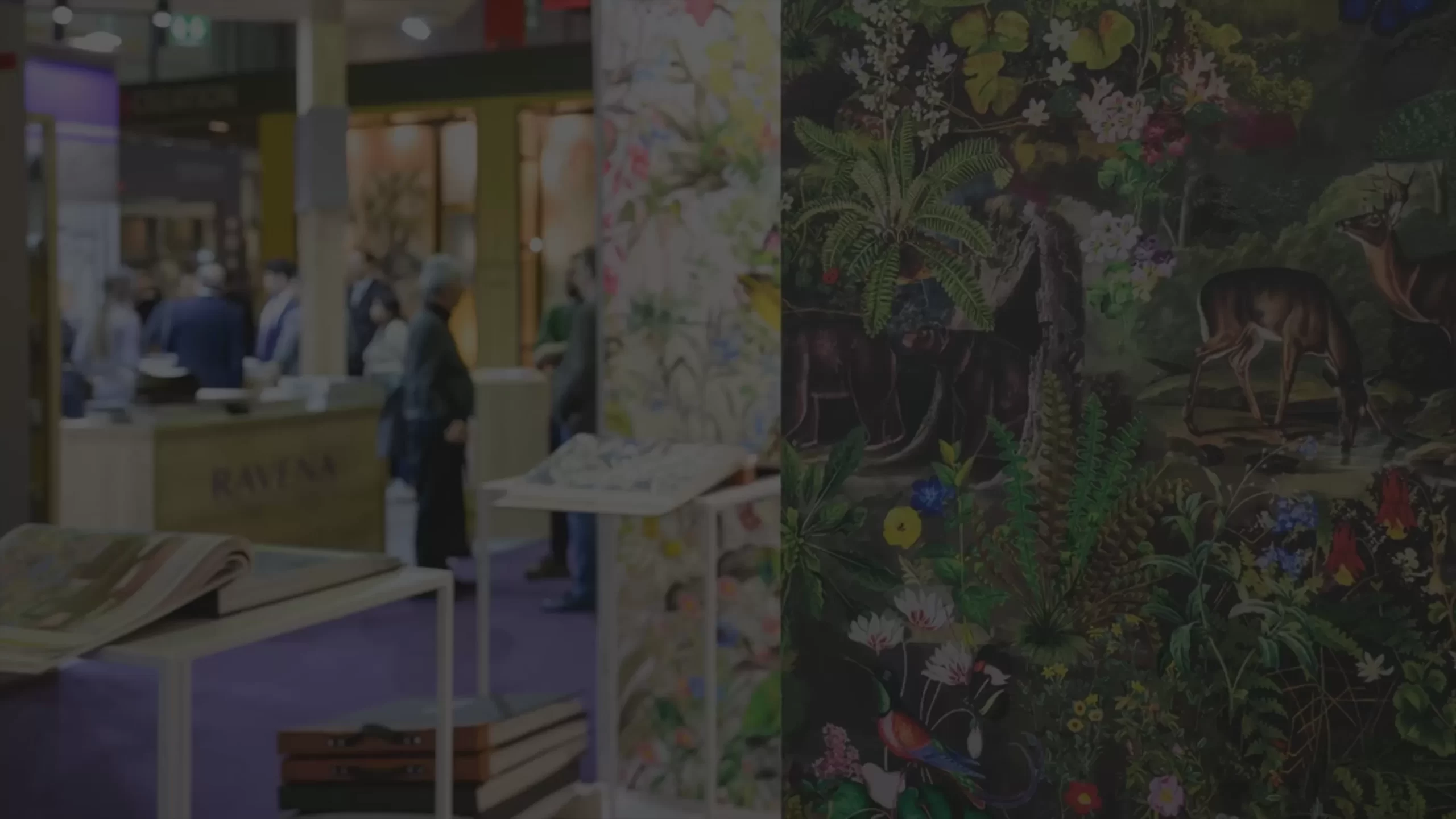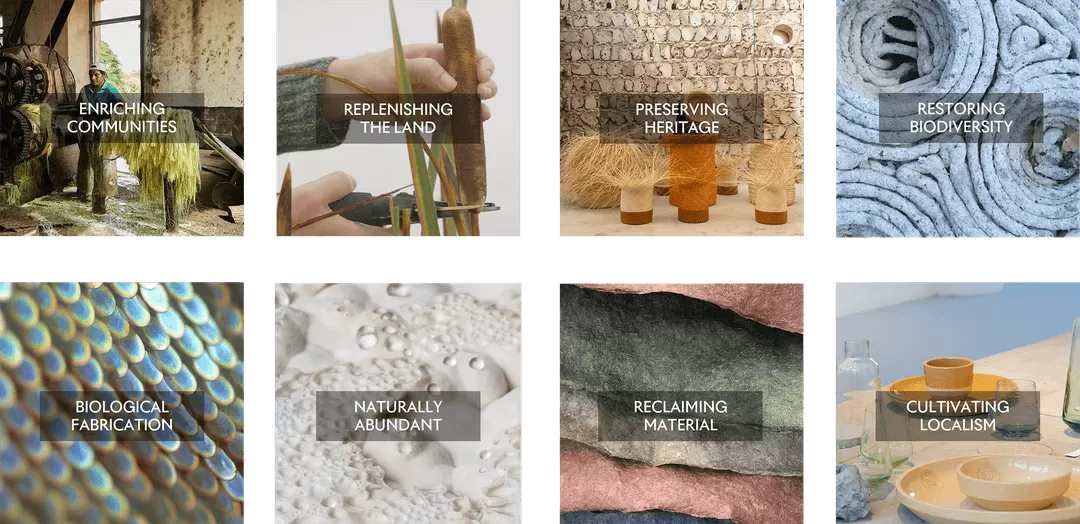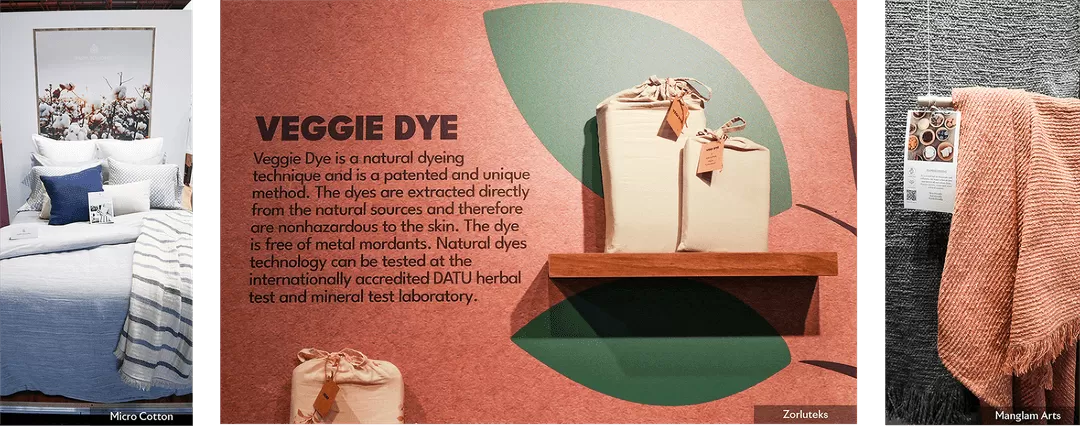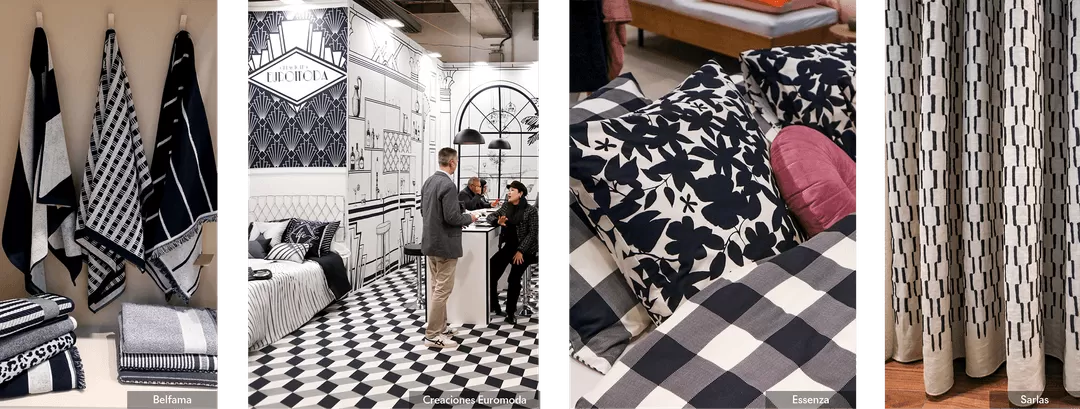
heimtextil
heimtextil
January 9-12, 2024
Frankfurt/Main

heimtextil
Introduction
The Heimtextil Trends offer forward-looking theme settings and spectacular showcases for textile professionals who want to constantly expand their knowledge.
Sustainability has been an integral component of the Heimtextil Trend Space for many years – in the Material Manifesto as the basis for sustainable design, in the “Regenerative” theme, which forms the Future Materials curated by Franklin Till
New Sensitivity is the overarching trend theme for the 24/25 season and is based on the Sustainable Development Goals of the United Nations. New Sensitivity transforms broadly and deeply and invites us to consider what we bring into the world and how it can contribute to a balanced nexus.

Lectures
heimtextil
Anja Bisgaard Gaede, the founder of SPOTT, has a Master’s degree in Communication, specializing in fashion, consumer behavior and experience economy. In addition to numerous presentations, product developments, strategy workshops and consulting activities over the past 12 years.
SPOTT trends & business provides Scandinavian lifestyle brands with in-depth customer knowledge as well as trend and color forecasts for their precise business development. SPOTT creates the crucial connection between future trends, consumer behavior and business opportunities. A new and innovative approach is needed that combines neuroscience and trend forecasts with commercial experience and thus turns trends into business success for Scandinavian lifestyle customers. The customer spectrum includes fashion and design companies, urban development projects, creative industry universities, retail, lifestyle and media companies.
heimtextil
In pursuit of creating colours that evoke emotions in our senses while at the same time respecting our values in protecting the environment, sensitive colouring methods of natural pigments deriving from the earth and new colouring processes of innovative bioengineering technology have created a dynamic yet subtle colour palette for Heimtextil Trends 24/25: New Sensitivity.
heimtextil
Plant-based textiles mean that the fibers are derived from something that grows rather than being synthetically produced. The sustainable advantage of plant-based textiles is that their origin is natural and, therefore, more eligible to recirculate in existing ecosystems. Plant-based textiles can be divided into two groups. The first group textiles are made from plant crops like cactus, jute and seaweed. The second group is textiles made of plant by-products which are leftover raw materials from production such as banana, olive, persimmon and hemp.
heimtextil
Bio-engineering bridges nature and technology and transforms the way textiles are made. They can be divided into two directions: fully bio-engineered and bio-enhancing biodegrading textiles. For fully bio-engineered textiles, nature-inspired strategies are adopted in textiles production. Textiles are made from the protein, carbohydrates in corn, grass, and cane sugar, or bacteria. Biodegradable fibers can be added to conventional textiles like polyester to enhance the conventional textiles’ ability to revert to materials found in nature.
heimtextil
Technology can support the transformation of textiles through different methods: upcycling and recycling of textiles, textile construction and textile design. Developing technologies for recycling textile waste and methods, or old textile construction techniques are ways to sustainable solutions. Textile Design Thinking is another method that addresses critical issues such as energy usage or durability of natural fibers and enhances these through technological textile advancement.
heimtextil
Anne Marie Commandeur heads a team of multi-disciplinary designers working on creation and communication in the area of material innovation, forecasting, colour trends and strategic design concepts. She lectures on trend forecasting and design applications, is an external examiner at various design academies and universities and is a regular speaker at international seminars and exhibitions. Stijlinstituut provides trend interpretations based on professional expertise – innovative design and product development based on a realistic lifestyle approach – and develops effective communication tools to transmit information through the value chain. With a constantly refreshed network of design talents and specialists, Stijlinstituut Amsterdam acts as a versatile and vibrant force in keeping the fashion and design industry informed of influential developments through consultancy, books, workshops, lectures, trend forums and editorials.
heimtextil
In the age of climate crisis, we are beginning to look beyond sustainability to regenerative design – but what does that actually mean and how do we define regenerative textiles and materials?
Human activities are already causing significant damage to our planet, so current sustainability efforts are not enough to address the environmental crisis we face. Regenerative design is committed to giving back something better -developing holistic creative practices that restore or renew resources, have a positive impact on the environment, and help communities thrive.
Design futures consultancy FranklinTill curated a global showcase of cutting-edge textiles and materials to illustrate the principles of regenerative design. By celebrating pioneering designers, producers and manufacturers at the forefront of regenerative design, we aim to encourage and accelerate change so that both people and planet can thrive.
heimtextil
heimtextil
Marta Giralt Dunjo, Design Director at FranklinTill Studio
FranklinTill is a design futures agency working with global brands and organizations to explore and implement design, material and colour strategies. These clients turn to them for insight into the shapes, colours and materials that will inform our live in the world of tomorrow, and for bespoke, sustainable innovation strategies to help them shape it. At the heart of everything they do there is a shared belief that research and innovation inmaterials and design are integral to a more sustainable future. They work closely with clients to identify design opportunities within contemporary cultural currents, giving them the ideas they need to thrive in a rapidly changing world.
heimtextil
Sequins are small disks of petroleum based plastic, using either a synthetic coating or metallic foil for the shimmering effect. They are widely used within all sectors of fashion, textile sand consumer goods, and have a long cultural relevance dating back to the Egyptian times.
Due to their size they are classified as a micro plastic and contribute to the growing global plastic problem. Sequins, like glitter, also leak into our environment, causing problems to human and planetary health.
Radiant Matter is developing a new generation of colour and material solutions for the circular economy. Inspired by nature’s ingenuity, we engineer naturally sparkling structural colours to help the textile industry dramatically reduce its environmental impact; our BioSequin™ embellishments are just the beginning.
Made from renewable and abundant cellulose, our biodegradable sequins give rise to brilliantly shimmering colours which are non-toxic, colourfast and pigment free. Their glittering metallic sheen is free from minerals, metals, and associated mining, offering an ethical supply chain.
heimtextil
PineSkins is a versatile material made of inner bark of pine trees, a by-product of the tree cutting industry. Ranging from earthy brown to pink, deep terracotta to ash-grey and a scent of wood, PineSkins carries a unique appearance that feels familiar yet unseen.
In order to become flexible, the freshly harvested bark is treated with a bio-softening solution and natural wax. The tactile material remains soft for long periods of time within a normal home ambience while also keeping its woody scent. PineSkins is a great material for various interior applications, such as walls, surfaces, veneer alternative.
On a broader level PineSkins looks at the resources of forests. It aims to create alternative production paradigms for the tree cutting industry with less emphasis on timber production. It does so by using small scale tree cutters as a network for bark access while they perform seasonal cutting. It then creates a new craft that generates income for local communities and creates appreciation for unassuming materials from the local forest.

Sustainability
heimtextil
Sustainable innovation and messaging were evident across all halls, with exhibitors showcasing their latest developments in textiles, fibers and wallpaper.
heimtextil
Planet-friendly naturals grow this season, with newness in botanical dyes and traceable materials. Delve into commercial naturals by swapping chemical-based dyes with botanical alternatives from food waste and plants. WGSN reported in Big Ideas of 2025, brands need to enter Preservation Mode by working with regenerative farmers and manufacturers to protect the earth’s resources.

Rest & Wellness
heimtextil
Exhibitors experiment with curtains and greenery to build inviting spaces. Work with fresh indoor trees and foliage to strengthen the biophilic connection to create a calming and tranquil space.
heimtextil
Sleep remains a priority for consumers, with exhibitors sharing innovative productsfor a better rest. Luxe bedding heightens users’ restorative time, with silk-inpired fabrics, collagen and CBD-infused textiles catering to skincare needs.

Print & Patterns
heimtextil
Lavish tropicals continue to trend at Heimtextil with supersized palms and colourful artwork. Expand the tropical narrative with the additions of birds, flowers and colourful backdrops.
heimtextil
Update this perennial story with pigmented hues and heirloom crafts. Build stories with tinted darks, indigo and autumnal pigments for a warming touch.
heimtextil
Traditional crafts are key for designing home textiles with authentic narratives and unique finishes. Update geometric stories with handcrafted look by combining diamonds, lines, and mirrored repeats into fresh designs.
heimtextil
Develop camo textures with ripples and abstracts illustrated from surfaces found in nature. This is highly commercial for large surface areas including rugs, drapes and wallpaper. Use fluid linework that are soothing to the eye. Experiment with shimmering elements to enhance the fantastical nature narrative.

Colour, Material & Finish
heimtextil
Experiment with different applications of metallics across woven and printed goods. Invest in sustainable material innovation emerging for embellishments. Material scientist company Radiant Matter (UK) offers BioSequins, which are being tried in the fashion industry and homewares. BioSqquins are made from renewable and abundant cellulose, making them biodegradable and non-toxic.
heimtextil
Expressive yellows are trending across home textiles and recent trade shows. Confirmed as a key colour for 2024 and beyond, use Pollen Yellow as a bright primary tone to energize interiors. Warmer varieties work well across textiles to intensify surface construction for an upmarket appearance.
heimtextil
Develop mid-tone reds that offer a futuristic and age-old theme, suitable for florals and tropical patterns. Build tone-on-tone for a sophisticated look across constructions. Pair this colour with white for a modern take or experiment by combining it with other pigmented red and pink hues for a fuller look.
heimtextil
Nuances of black and white bring a timeless quality to everyday home textiles. Soften the appearance with hand-stitch edging, machine embroidery in textiles or flock printing. Test near-black tones paired with off-whites using natural plant-based materials to give this simple colour story an upmarket feel.






















